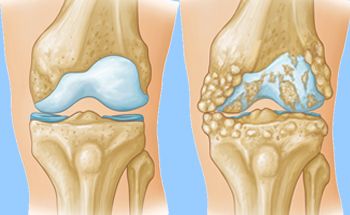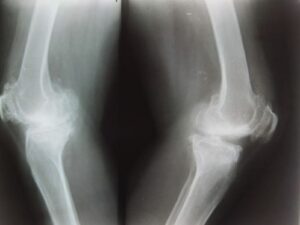Knee Arthritis
Knee arthritis is an inflammation and deterioration of the cartilage of the knee joint. The flexible coating on bone ends known as cartilage acts as a cushion and facilitates the knee’s easy bending and straightening. Knee cartilage covers the top of the tibia, the rear of the kneecap, and the ends of the femur and thighbones (patella). As the cartilage wears away, the space between the bones deteriorates. Bone may rub against bone and develop bone spurs (bumps on the bone) in severe arthritis of the knee.

Types Of Knee Arthritis
-
Osteoarthritis of the knee
The knee is one of the most often affected joints by osteoarthritis, the most prevalent type of arthritis. Osteoarthritis results in the thinning of the cartilage in your knee joint and the roughening of the joint surfaces, which causes the knee to move less smoothly than it should and may feel painful and stiff.
Anyone can develop osteoarthritis at any age, although women over 50 are more likely to develop it.
Osteoarthritis can increase a person’s risk of injury or other joint issues, such as gout. Our genetics may potentially enhance the likelihood of developing the illness.
Being overweight puts additional strain on weight-bearing joints like your knees, which is another cause of osteoarthritis.
-
Rheumatoid Arthritis
Rheumatoid arthritis, a persistent inflammatory disorder, can affect your joints and various physiological systems such as the skin, eyes, lungs, heart, and blood vessels in certain individuals. This autoimmune disease occurs when the immune system mistakenly attacks the body’s tissues.
-
Post-traumatic Arthritis
Post-traumatic arthritis is joint inflammation that develops after you’ve been injured.
It makes your afflicted joints stiff and painful. Although surgery is unlikely, it can take a few months before you feel better. Post-traumatic arthritis can be brought on by any joint injury, including those sustained in sports injuries or car accidents.
Causes & Symptoms of Arthritis of Knee
What causes arthritis of knee?
Some genes might be behind it, but there could be more we haven’t found yet. You might have a gene linked to arthritis without knowing it, and something like a virus or injury could start it.
Even though we’re not sure what exactly causes it, some things make it more likely to happen:
- Age: Older adults get knee arthritis more than younger adults or kids.
- Bone problems: If your bones or joints are naturally bent or crooked, you might have a higher chance of getting knee arthritis.
- Gout: Another type of arthritis, gout, can sometimes lead to the same.
- Injuries: If you hurt your knee, it might end up with arthritis.
- Stress: Doing a lot of activities like jogging, sports, or having a very active job can put stress on your knees and lead to knee arthritis.
- Weight: Having extra weight can put more pressure on your knees and make it more likely.
What are the symptoms of arthritis of the knee?
- Sounds like creaking, clicking, grinding, or snapping noises (crepitus) from knees.
- Difficulty walking.
- Joint pain that changes (gets better or worse) depending on the weather.
- Knee Joint stiffness.
- Knee buckling.
- Gradual or abrupt onset of knee joint discomfort
- Skin redness.
- Swelling.
- Your knee locks or sticks when it’s trying to move.
- Warm skin. Pain and swelling are the most common symptoms of arthritis of the knee.
Certain therapies could alleviate symptoms or potentially halt the advancement. Seek medical advice from Dr. Preetesh if you experience arthritis of knee symptoms.
Diagnosis and Testing
How is knee arthritis diagnosed?
Your healthcare provider will likely request knee X-rays to assess for arthritis. The X-rays will indicate:
- The specific type of arthritis.

- Any bone alterations.
- Presence of bone spurs.
- The degree of narrowing in the space between bones correlates with cartilage loss and pain severity.
Occasionally, healthcare providers may order a magnetic resonance imaging (MRI) test or a computerized tomography (CT) scan.
Treatment for knee arthritis
Treatment for knee arthritis varies depending on factors such as the type and stage of arthritis, your age, severity of pain, and other considerations. While cartilage loss cannot be reversed, there are methods to alleviate pain and hinder further damage. Nonsurgical approaches to knee arthritis treatment encompass:
- Modifying activities to mitigate joint pain and inflammation, which may involve avoiding high-impact exercises like running and jumping while prioritizing low-impact activities to stay physically active and manage symptoms.
- Participating in physical therapy to enhance strength and flexibility.
- Considering weight loss if applicable, to diminish stress on the joint.
- Utilizing braces for added joint stability.
- Employing medications and injections, such as hyaluronic acid injections, to manage pain, inflammation, and facilitate healing.
- Using walking aids like canes or walkers to provide support.
The progression of knee arthritis and the efficacy of nonsurgical treatments can vary.
